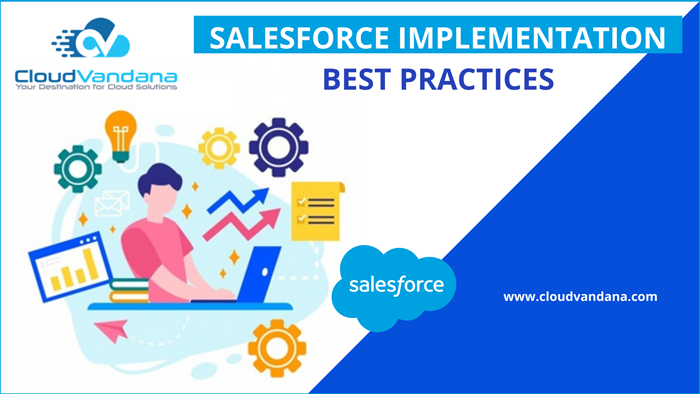Salesforce is the leading CRM (Customer Relationship Management) solution provider with unlimited possibilities. Salesforce aims to manage complex business challenges and enhance businesses. But to get all the benefits, organizations need to implement Salesforce properly; otherwise, companies cannot touch the desired goal. In this blog, CloudVandana will discuss the best practices of Salesforce and the stages involved in this implementation process.
Though the implementation process is user-friendly, still, it is highly recommended to hire a registered Salesforce partner for a successful implementation. The time taken in this implementation process depends on the requirements and size of the organization. Generally, it takes 15-20 days, but this span can be extended for a more customized and intensive implementation. Before going for an implementation process, organizations need to understand the basic steps and strategies involved. This understanding will help the organization increase speed and reduce costs.
Following are the best practices and strategies to implement Salesforce for an organization.
1. Planning
Planning is the first step involved in any process. So similarly, for Salesforce implementation, proper planning should be there depending on the needs and scalability of the organization. The implementation process mainly depends on the type of business. So for B2B or B2C companies, the implementation process should be based on the customers’ pain points so that a customized solution can be delivered.
2. Set The Timeline
After the planning, organizations need to set the timeline to avoid the project overlapping. So maintaining a project schedule is very much essential. In addition, admins can target short-term achievements for better implementation assessments. These short-term goals will help to achieve significant milestones.
3. Calculate The Cost
For a successful implementation, organizations need to calculate the cost related to the performance to calculate the ROI correctly. The implementation cost includes consultation fees of the registered Consulting Partner’s consultation fees and data migration and customization expenses. In addition, after the successful implementation, training program costs and maintenance charges should be added to the list.
Organizations can select the Salesforce edition depending on the number of users in the organization. There are four editions available- Sales Essentials, Professional, Enterprise, and Unlimited. In addition, organizations can select based on their needs and budget.
4. Set The Goal
Admins should set significant goals and objectives depending on the organizational workflow. The goals should be measurable, time-based, and realistic.
5. Deploy
Before the deployment, admins can customize the CRM solution as per the organizational process. But it is highly recommended to keep the first deployment as simple as possible. Then, added features can be included in the ecosystem whenever needed later on based on customer feedback.
The admins should coordinate with the users in the organization to help them overcome the challenges and adopt the new ecosystem.
6. Training For Proper Adoption
After the successful implementation, companies should conduct a training process for successful adoption and running the CRM without any human error.
These were the basic implementation processes. But there are many other steps involved in post-implementation. For example, Salesforce releases three updates per year to enhance user experience. Therefore, organizations should update the editions with all three outs with the help of the Salesforce consulting partners to avoid any unnecessary complications.
Are you looking for a registered Salesforce partner for a successful Salesforce implementation? Please feel free to contact CloudVandana for all your Salesforce needs and get the total ROI of your Salesforce investments.










